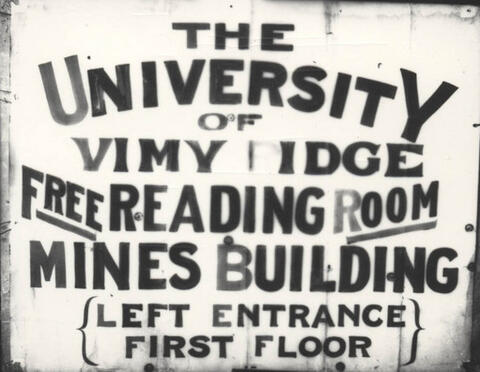
Title and statement of responsibility area
Titel
University of Vimy Ridge Sign
Algemene aanduiding van het materiaal
- Graphic material
Parallelle titel
Overige titelinformatie
Title statements of responsibility
Titel aantekeningen
Beschrijvingsniveau
Stuk
archiefbewaarplaats
referentie code
Editie
Editie
Edition statement of responsibility
Class of material specific details area
Statement of scale (cartographic)
Statement of projection (cartographic)
Statement of coordinates (cartographic)
Statement of scale (architectural)
Issuing jurisdiction and denomination (philatelic)
Datering archiefvorming
Datum(s)
-
[1916-1918] (Vervaardig)
- Plaats
- France
Fysieke beschrijving
Fysieke beschrijving
1 photograph : b&w ; 17.5 cm x 12.5 cm
1 negative : b&w ; 10.5 cm x 8 cm
Publisher's series area
Title proper of publisher's series
Parallel titles of publisher's series
Other title information of publisher's series
Statement of responsibility relating to publisher's series
Numbering within publisher's series
Note on publisher's series
Archivistische beschrijving
Naam van de archiefvormer
Geschiedenis beheer
Bereik en inhoud
University of Vimy Ridge signage.
Bio/Historical Note: Khaki University (initially Khaki College or University of Vimy Ridge) was a Canadian overseas educational institution set up and managed by the general staff of the Canadian Expeditionary Force (CEF) in Britain from 1917-1919 during the First World War. The system, named for the khaki-coloured uniforms of the CEF, was set up by the efforts of Dr. Edmund Henry Oliver, Professor of History and Economics, University of Saskatchewan, and others and was supported by the Young Men's Christian Association (YMCA). The University, with makeshift colleges mainly in central England, was intended to be “a school of efficiency and citizenship, a sort of combination of an Agricultural High School and a Technical School.” Courses were offered in Agriculture, Business Efficiency, Elementary Practical Science, and Citizenship. Classes were scheduled so that battalions could attend during their rest periods. Certificates given were accepted by Canadian universities. An important part of the University’s services was a network of thirty libraries that served more than 50,000 soldiers. Operations were suspended in April 1918 because of the massive German offensive. The war was over by November and Oliver returned to Canada. The term was used again for Canadian educational programs for veterans from 1945-1946 after the Second World War.
Aantekeningen
Materiële staat
Directe bron van verwerving
Ordening
Taal van het materiaal
Schrift van het materiaal
Plaats van originelen
Beschikbaarheid in andere opslagformaten
Restrictions on access
Termen voor gebruik, reproductie en publicatie.
Copyright: Public Domain
Toegangen
Associated materials
Aanvullingen
Location note
vol.27b/neg.vol.4
Alternative identifier(s)
Standard number area
Standaard nummer
Trefwoorden
Onderwerp trefwoord
Geografische trefwoorden
Naam ontsluitingsterm
- University of Vimy Ridge (Onderwerp)
- Khaki University (Onderwerp)

